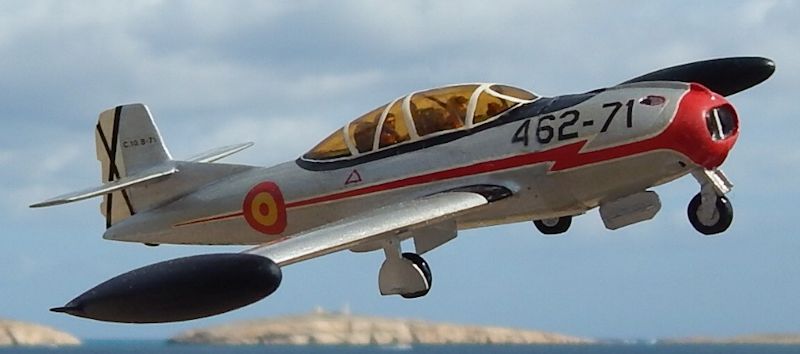
Replica 1/72 Ha.200/220 Saeta/Super Saeta
| KIT #: | ? |
| PRICE: |
|
| DECALS: | Three options |
| REVIEWER: | Carmel J. Attard |
| NOTES: |
Resin kit |

| HISTORY |
Simple and straight forward in design and as light and responsive as its
ancient namesake (Saeta meaning arrow) in hands of a skilled bowman the Saeta’s
slender profile is reminiscent of a shaft from a bow as it streaks across the
airfield of San Pablo near Seville, Spain.
Designed and built by Hispano Aviacion, whose design department was then
headed by Professor Willy Messerschmitt, the HA-200R-1 Saeta compared
most-closely to France’s Potez-Air-Fouga Magister but is smaller and lighter
than its French countemporary. It provided Spanish Air
Force with a modern jet
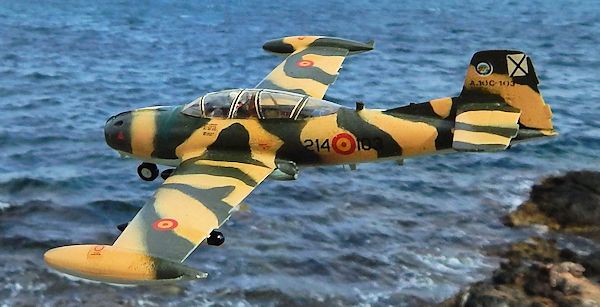 trainer
which was both simpler aned less expensive than those that would otherwise have
been produced from abroad.
trainer
which was both simpler aned less expensive than those that would otherwise have
been produced from abroad.
The first of two Saeta prototypes (EC-AMM) was flown for the first time
on August 6th 1955 by Hispano’s
test pilot Major Fernando de Juan Valiente at San Pablo, Seville’s main airport.
It was quickly ascertained
that the Saeta had excellent handling characteristics.
Initial flght tests also revealed that some slight modifications were necessary
and the wing dihedral was increased to three degrees 50 minutes and dorsal fin
area enlarged and vertical fin heightened.
The HA-200 was in production for service with the Spanish Air Force as
the E-14 two-seat advanced flying and armament trainer. The two prototypes were
followed by five pre-production models and 30 HA-200As (first flight October 11th
1962). The HA-200A had two 880 lbst Turbomeca Marbore’ IIA turbojets and
armament of two 7mm machine guns and underwing rockets.
The HA-200B developed for the Egyptian Air Force and was in production
at Helwan as Al-Kahira. It differed from the A mainly in having a single 20mm
cannon and different equi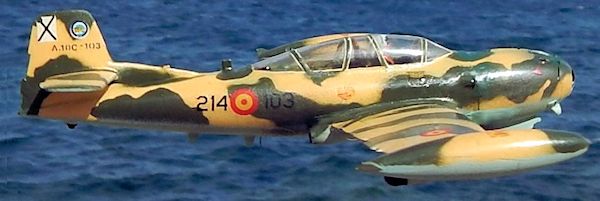 pment.
The 55 HA-200Ds built for the Spanish Air Force in 1965-68 have modernised
systems and heavier armament.
pment.
The 55 HA-200Ds built for the Spanish Air Force in 1965-68 have modernised
systems and heavier armament.
A further development version was the HA-200E Super Saeta with 1,056
lbst Marbore’ VI turbojets and more extensive and modernised equipment. From
this version has evolved
the externally similar, single seat HA-220 ground attack
aircraft, of which 25 were built for the Spanish Air Force. Maximum speed of the
type was 404 mph and a range of 930 miles.
| THE KIT |
Released in 1992 by Replica of France the resin kit of the Saeta and
Super Saeta model is very well done with surprising surface detail. The kit
practically comes as a main structure molded in one piece. This consists of a
fuselage, wings and tail for all in one as depected on the instructions. This
gives the impression that very little work left for the modeler. This can be a
bonus for those who
like to get the
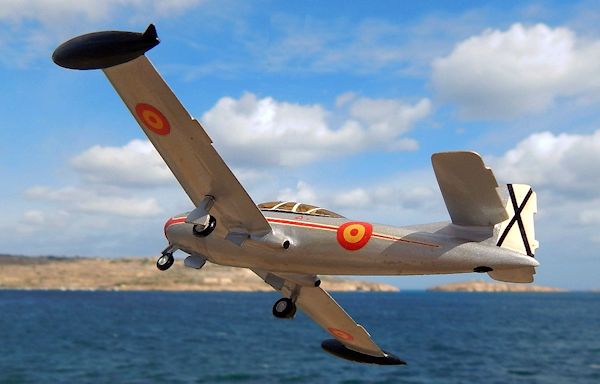 modeling
out of the way as quick as possible in order to spend more time on coloring and
detailing the model.
modeling
out of the way as quick as possible in order to spend more time on coloring and
detailing the model.
Box art cover is beautiful which depicts a Super Saeta (attack version)
in action firing underwing rockets while on the side of the box there is a
colored side view of the Saeta (trainer version). Besides these
color markings
that come in decal sheet form, there is also decal for
an overall silver trainer of the Saeta B that was in service in 1967 with the
Egyptian Air Force. Instructions are in French language there are A4 size detail
4-view drawings showing the camouflage pattern or the placement of the decal
sets with respect to all of the three varieties. The exploded assembly view is
self explanatory showing all the kit parts and where each item goes on the kit.
The model , being of solid resin tend to be on the heavy side and this
gives the impression that the
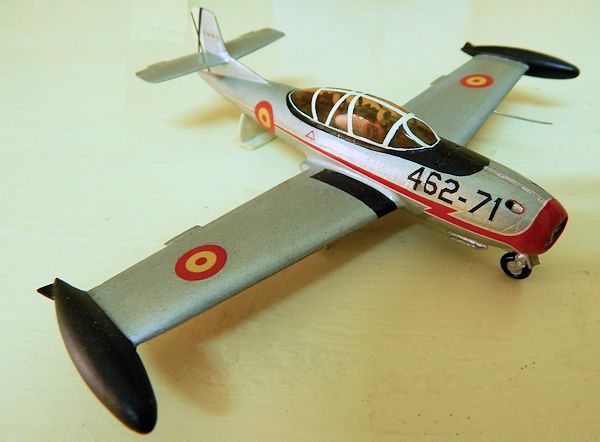 undercarriage
is somewhat frail to take the weight. The fuselage and wings are in one piece
with two versions for the forward nose and separate air intake in order to make
either version of the Saeta.
undercarriage
is somewhat frail to take the weight. The fuselage and wings are in one piece
with two versions for the forward nose and separate air intake in order to make
either version of the Saeta.
In this context I took the advantage of the situation and went a step
further and made myself a second copy of the fuselage / wing integral part and
cast same in Aluminium. Having this extra part I then could add the extra nose
items and stores provided to end up with making the two versions.
Smaller parts including seats, undercarriage and tail planes come as
separate items that could be easily scratch built for the second kit. Under
fuselage and underwing rocket pods or miniguns are provided for the attack
version. There is
also included a long glazed, well reprodeced
canopy.
| CONSTRUCTION |
The porosity free resin fuselage was first cleaned from any tiny fins
and was used as pattern
to make another copy in cast aluminium alloy. As
Aluminium solidifies it undergoes liquid as well as solid contraction, so the
pattern was gently rapped and the little oversize cavity
made up for the
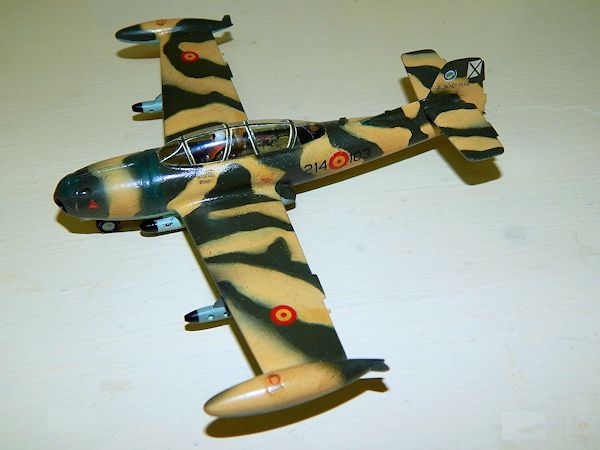 contractions
to produce the same nose with same dimensions as the resin one, with the
understanding that the resin one contained the exact dimensions in scale. The
cast fuselage then had the runner cut, and the fuselage smoothened with files
and fine wet and dry paper.
contractions
to produce the same nose with same dimensions as the resin one, with the
understanding that the resin one contained the exact dimensions in scale. The
cast fuselage then had the runner cut, and the fuselage smoothened with files
and fine wet and dry paper.
The next stage was to mold a clear canopy identical to the kit one. This
entailed making a solid wooden male patern of similar shape and again molded one
from acetate using home gas cooker to warm up and soften the clear acetate. Like
many vac canopies this had yellowed in no time. Then sorted out a set of wheel
legs, wheels, well doors, seats and crew figures all from spares while a new set
of tail planes was cut and shaped from soft plastic card.
I have used super glue all the way
to join parts together. With a very clear canopy my
attention now fell to detailing the cockpit office interior. On this occasion I
have made use of locally produced ‘Modelaid’ printed cockpit interior set for
the Saeta. Also added instrument panel, column etc., for both kits. A point of
note is that the attack version i.e. the Super Saeta, only carried a single crew
seat at the front.
| COLORS & MARKINGS |
I decided on the two Spanish Air Force versions. The Super Saeta HA-220
belonging to 214 squadron was camouflaged in sand and green upper s urface
and light blue undersurface using Humbrol enamel paint. The box art was good
reference to select the correct colors. This ground attack version carried
miniaturised roundals and tail markings. The other kit, the one that I cast was
completed in overall silver with black anti glare panel. Kit red lightning trim
decal decorated the length of the fuselage sides. I have kept the Egyptian
roundels for later use when the turn comes to make an Egyptian AF Yak 11
trainer. The resin kit could rest on the front nose wheel but the cast aluminium
one was too heavy at the rear and needed a prop to make it rest on the nose
wheel.
urface
and light blue undersurface using Humbrol enamel paint. The box art was good
reference to select the correct colors. This ground attack version carried
miniaturised roundals and tail markings. The other kit, the one that I cast was
completed in overall silver with black anti glare panel. Kit red lightning trim
decal decorated the length of the fuselage sides. I have kept the Egyptian
roundels for later use when the turn comes to make an Egyptian AF Yak 11
trainer. The resin kit could rest on the front nose wheel but the cast aluminium
one was too heavy at the rear and needed a prop to make it rest on the nose
wheel.
| CONCLUSIONS |
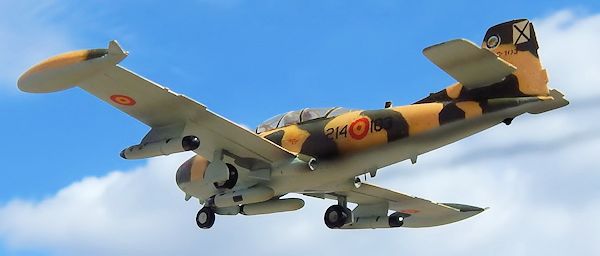 What
can I say about the Replica kit
except that it is definitely recommended for the post
war jet era trainer enthusiast. Perhaps with an additional increase in price
Replica could include a second fuselage-wing solid part with the kit for a small
increase in cost to make it easier for the modeler to make the second kit and
saves one the extra work I had to go through.
What
can I say about the Replica kit
except that it is definitely recommended for the post
war jet era trainer enthusiast. Perhaps with an additional increase in price
Replica could include a second fuselage-wing solid part with the kit for a small
increase in cost to make it easier for the modeler to make the second kit and
saves one the extra work I had to go through.
| REFERENCES |
Ref: Warplanes of the world, Ian Allan publication.
Editor's Note: For those who want a standard kit, MPM/Special Hobby do the Ha.200 in normal plastic.
September 2013
If you would like your product reviewed fairly and fairly quickly, please contact the editor or see other details in the Note to Contributors.